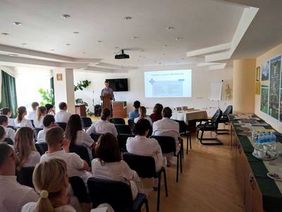One of the most important issues for professionals working with CP patients is muscle spasticity. This is a clinical syndrome that can significantly affect the development of a child’s motor functions, so spasticity control is one of the main goals of treatment.
Anna Kushnir talked about the latest studies carried out by the research team, which indicate a statistically significant decrease in spasticity after biomechanical spine correction has been performed on patients with cerebral palsy.
Functional hand disorders constitute an equally important problem related to the rehabilitation of patients with cerebral palsy. Scientists Marko Hasyuk and Oles Matyushenko spoke about diagnostic options for this disorder and informed the audience about the ABILHAND-Kids questionnaire, a measure of manual ability for children with upper limb disorders, and the Jebsen-Taylor Hand Function Test.
ABILHAND-Kids is one of the most popular questionnaires for evaluating hand functions in children aged 6 to 15. It must be filled in by the child’s parents, and measures the child’s ability to manage 21 daily manual activities. The questionnaire was developed and adjusted specifically for patients with cerebral palsy. Filling in the document takes up to ten minutes. Detailed instructions are available on the developer’s website ( www.rehab-scales.org/abilhand-kids.html ).
The Jebsen-Taylor Test is one of the oldest tools and has often been tested for reliability. It enables medical professionals to quantify hand functions. This test is suitable for patients aged over five, provided that the patient understands the instructions. The authors tried to make the test as practical as possible, that is, they created a test assessing the performance of the patient’s manual hand functions required for daily activities. The tool consists of seven subtests, which must be completed within a certain time limit. More information about the tests is available on the website of the East European Academy of Childhood Disabilities.
Working Meeting with Scientists from the International Clinic of Rehabilitation

